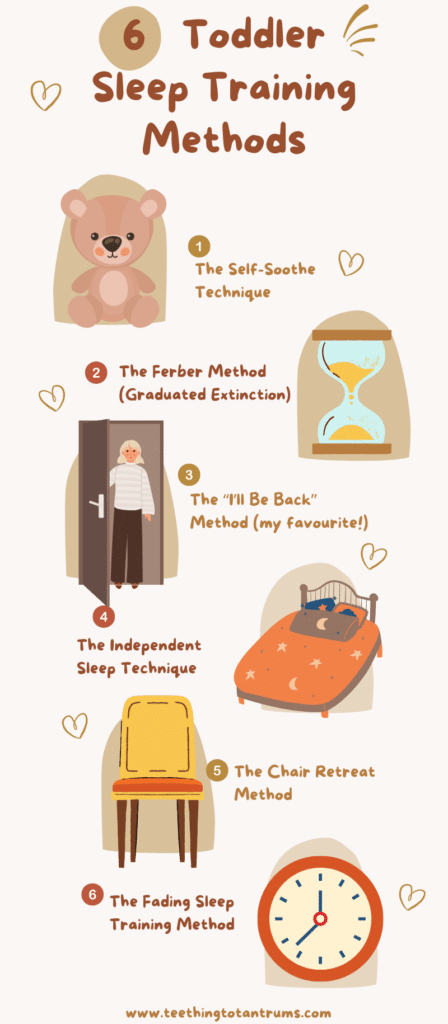Wondering what it’s really like when it comes to sleep training a toddler or preschooler? Read on to find out how to sleep train, sleep training methods, and tips and tricks to sleep train toddlers quickly, effectively and as hassle-free as possible.
What Is Sleep Training?
Sleep training a toddler is the process of teaching your child to sleep independently through the night without needing your help. While it may seem daunting, it is a valuable tool for exhausted parents. There are several toddler sleep training methods to choose from, including the Ferber method, graduated extinction, extinction, and fading method.
Importance Of Sleep Training For Toddlers
Sleep is crucial for a toddler’s physical and mental development.
Lack of sleep can lead to behavioral problems, mood swings, and a weakened immune system.
Not to mention that you as a parent of a toddler that will not sleep will end up being totally exhausted and short-tempered.
Therefore, teaching your toddler to sleep is an investment in your parenting… because a well-rested parent is a better parent.
Sleep training a toddler can help them develop healthy sleep habits, making it easier for them to fall asleep on their own and stay asleep through the night.
It’s important to note that my sleep training methods do not involve the “cry it out” method.
While some methods may involve some crying, the goal is to teach your toddler to self-soothe and learn to sleep independently, not to ignore their needs.
REMEMBER: Every child is different, and there is no one-size-fits-all approach to sleep training. It may take time and patience, but with consistency and perseverance, your toddler can learn healthy sleep habits and get the rest they need to thrive.

Benefits Of Sleep Training A Toddler
Sleep training a toddler has some incredible short-term and long-term benefits for both you and them.
In the short-term, sleep training your toddler will help them to:
- Fall asleep faster. Your toddler will learn the cues for sleep, meaning their body will unconsciously start winding down for bed once you get into a consistent routine.
- Sleep longer. Sleep training will also help your toddler to get into an age-appropriate day and sleep schedule which, if correctly aligned, will help your child to sleep for longer at night.
- Wake up less at night. Sleep training also teaches your child to be an independent sleeper, so they can put themselves back to sleep when they wake up throughout the night.
In the long-term, sleep training has a profound impact on your toddler’s physical and mental development:
- Improved cognitive and learning skills. The Journal of Epidemiology and Public Health published a study finding students who had consistent bedtimes performed better in school, while research from The Japanese Society of Child Neurology found that late bedtimes in 18-month-olds led to poorer results on cognitive development, a situation that can easily be overcome by sleep training.
- Improve mood for both YOU and your toddler. A study conducted to find the impact on sleep in young children and maternal mood, found that children with bedtime routines will have significant reductions in problematic sleep behaviors, bedtimes were at a more appropriate time and the number/duration of night wakings reduced to! Making parents and children far happier.
- Reduced chance of obesity. Getting enough sleep as a toddler is shown to reduce the likeliness of obesity in children. Which I find astounding!
Looking to get your little one to sleep quickly and effortlessly? Check out my Bedtime and Nap Cheat Sheet and master the art of making daytime naps and bedtimes as seamless as possible.
A bedtime & nap cheat sheet so good your little one will ask you to put them to bed...
Laura Williams "This is a life saver! I'm so glad I downloaded your bedtime & nap cheat sheet. My little one actually asked me to put him to bed last night! Unbelievable! Thank you so much!"
Click Here For The FREE Cheat Sheet
How To Sleep Train A Toddler
Preparation is key.
This statement is one of the first things I learnt at Norland and it’s a lesson I will continue to share with everyone I meet!
So, before you begin sleep training a toddler, it’s important to set the stage for success.
This means establishing a consistent bedtime routine that helps your child feel comfortable and secure.
- Bedtime routine. When establishing a bedtime routine, consider your child’s individual needs and preferences. I find that the basic bath, book and bed routine is the best place to start. However, you can tweak the routine to suit your toddler’s individual needs. Whatever you choose, make sure it is something that your child finds comforting.
- Consistency. Consistent and stable routines will set your toddler up for building strong sleep associations. Try to establish a set routine that you follow every night, so your child knows what to expect. This can help them feel more secure and relaxed, making it easier for them to fall asleep. This includes keeping bedtime at the same time every night.
- Sleep environment. As you prepare for sleep training a toddler, it’s also important to consider their sleep environment. Make sure their room is quiet, dark, and cool, and consider using white noise to help block out any distracting sounds.
- Security blankets or favorite toys. Many toddlers have a special toy or blanket that helps them feel secure. Make sure your child has access to this item at bedtime, and consider purchasing a backup in case it gets lost or damaged.
- Limit screen time before bed. The blue light emitted by electronic devices can interfere with sleep, making it harder for your child to fall asleep and stay asleep. Instead, encourage quiet activities like reading or coloring before bed.
By taking the time to prepare for sleep training a toddler, you can set yourselves up for success and make the process smoother and more effective.
Implementing Toddler Sleep Training Methods
It’s important to remember that every child is different, and what works for one may not work for another. It is also important to choose a sleep training process that you are fully invested in and happy with.
Here are a few methods to try that I have found very effective:

1. Self-Soothe Technique
Encouraging your toddler to self-soothe can be an effective toddler sleep training method.
This involves teaching your child to fall asleep on their own without relying on external factors such as rocking or feeding.
Start by putting your little one to bed when they are drowsy but still awake, and give them a comfort object like a stuffed animal to hold onto. Encourage them to soothe themselves by singing or talking quietly to themselves.
If they do complain or whine, wait a little while before going back to help resettle your toddler.
Do not talk, keep the lights off, and do not pick them up. Your toddler needs to learn that bedtime means bedtime.
2. Ferber Method (Graduated Extinction)
The Ferber method is a form of sleep training a toddler (and babies!) developed by pediatric sleep expert Dr. Richard Ferber.
When using this method, you put your toddler to bed at the end of their regular bedtime routine, say good night leave them to fall asleep independently.
If they begin to whine, wait about 3 minutes then reenter the room, calmly resettle your child (without picking up or making a big fuss), say good night and leave again. Repeat as many times as necessary.
The Ferber method gives toddlers the opportunity to learn to fall asleep on their own and is usually considered a gentle sleep training method.
3. “I’ll Be Back” Method
This is one of my personal favourite toddler sleep training methods for toddlers and is based on the Ferber method with a little twist.
Once you’ve put your child to bed, tell them you need to go do something really boring (such as laundry, emails or washing up) and that you’ll be back in 5 minutes.
Once the time has passed, make sure you return no matter what.
This process is what builds up your child’s trust in you.
From there you can repeat the process (either doing the same chore or a new one) and say you’ll return in 8 minutes.
You keep repeating until your child is asleep on your return.
4. Independent Sleep
Teaching your toddler to sleep independently can also be helpful.
This involves gradually reducing your involvement in your child’s bedtime routine until they are able to fall asleep on their own.
Start by reducing the amount of time you spend rocking or holding your child before bed. Once you have put them to bed, stay near their bed and each night gradually move further and further away until you are putting them down and leaving straight away and they are able to fall asleep without your presence.
5. Chair Method
Similar to the independent sleep method, sleep training a toddler with the chair method involves sitting in a chair next to your child’s bed until they fall asleep.
Each night, move the chair further away from the bed until you are eventually out of the room altogether.
This method can be helpful for children who have a hard time falling asleep without a parent being present.
6. Fading Sleep Training Method
The fading sleep training method involves gradually reducing the amount of time you spend soothing your child to sleep.
Start by reducing the amount of time you spend holding, rocking or patting your child before bed, and gradually decrease the amount of time each night until your child is able to fall asleep on their own.
REMEMBER: Be patient and consistent when implementing these methods. It may take some time for your child to adjust to a new routine, but with patience, persistence and positive reinforcement, you can help your child develop healthy sleep habits.
Dealing with Challenges in Sleep Training
Sleep training a toddler can be a challenging process, and you may encounter some difficulties along the way. Here are some tips to help you navigate common challenges and sleep issues:
1. Maintain Healthy Sleep Habits
To ensure successful sleep training, it’s important to establish healthy sleep habits. This includes:
- A consistent bedtime routine including setting a regular bedtime and wake-up time,
- Ensuring your child gets enough age-appropriate sleep during the day. Overtired toddlers will struggle to fall asleep so it is essential that they get enough daytime sleep or rest. If your toddler does not want to nap in the day encourage them to have quiet time instead.
- Avoid caffeine and sugary snacks before bedtime.
TOP TIP: Having a white noise machine, black-out blinds, audiobooks and toddler alarm clocks are all great ways to help your toddler fall asleep independently and deal with night wakings.
2. Bedtime Tantrums
If your toddler throws a tantrum during bedtime, it’s important to stay calm and firm. Offer reassurance and comfort, but avoid giving in to their demands.
If you give in once, they’ll realise they can get away with it!
Stick to the established bedtime routine and be consistent with your approach.
3. Bedtime Battles
If your child resists going to bed, try to make the process fun and engaging.
Having a consistent bedtime routine that includes bath, book and bed is essential.
Create a cosy sleep space for your little one and make use of white noise machines and or audiobooks.
Avoid stimulating activities like screen time and sugary high caffeine food before bed as this can make it harder for your toddler to fall asleep.
4. Separation Anxiety
Separation anxiety is a common cause of toddlers not wanting to be left at bedtime.
If your child struggles with separation anxiety, try gradually increasing the amount of time you spend away from them during the day.
This can include leaving them with a relative or friend for short periods of time, and encouraging them to play alone in a safe place during the day with you checking in on a regular basis. This can help them build confidence and independence.
You can also try leaving a comforting item like a favorite stuffed animal or blanket in their bed.
5. Illness
If your child is sick, it’s important to prioritize their health and comfort over sleep training.
Offer extra comfort and care, and try to maintain a consistent sleep routine as much as possible.
Once your child is feeling better, you can resume your sleep training efforts.
6. Nighttime Fears
It is common for toddlers to develop a fear of the dark and this may affect their ability to fall asleep independently.
If this is the case you will need to address the fear carefully by making them feel as safe as possible.
Read books that address fears of the dark like: When You’re Scared of the Dark alongside nightlights to put your toddler’s mind at ease.
Discover How To Create Stress-Free Bedtimes & Peaceful Daytime Naps, Consistently...
Without Tears, Tantrums or Showdowns
✅ Your parenting superpower to unlock calm evenings for years to come! 😌
✅ How to craft a calm and consistent bedtime routine that will get your little one falling in love with sleep… 🛌
✅ Uncover the techniques that the famous “Norland Nannies" use so you can get your little one going to bed and staying there! 🎉
✅ The secret to ending nighttime waking… to ensure your little one is getting enough sleep to thrive and reach their full potential! ❤️
✅ A super simple trick you can use to end hyperactivity before bed … so your little one will happily go to bed when you want them to 🌟
REMEMBER: Always be understanding and never dismiss your toddler’s fears as silly. To them, the fears are very real.

Role of a Pediatrician and Sleep Consultant
When it comes to sleep training a toddler, there are two professionals who can play an important role in the process: your pediatrician and a sleep consultant.
Your pediatrician can provide valuable advice and guidance on your child’s overall health and development. They can also help you determine if your child is ready for sleep training and offer suggestions for safe and effective methods.
A sleep consultant, on the other hand, specializes in helping families develop personalized sleep plans for their children. They can provide support and guidance throughout the sleep training process, helping you navigate any challenges that may arise.
Working with both a pediatrician and a sleep consultant can be a great way to ensure that your child’s sleep training is safe, effective, and tailored to their individual needs.
Ultimately, the role of a pediatrician and sleep consultant is to provide support and guidance as you help your child develop healthy sleep habits.
With their help, you can create a sleep plan that works for your family and helps everyone get the rest they need.
REMEMBER: It’s important to note that not all pediatricians or sleep consultants may be on board with sleep training… Some may have different opinions or approaches to sleep training a toddler, so it’s important to find professionals who align with your parenting style, values and goals.
Frequently Asked Questions About Sleep Training A Toddler
Looking for more information about sleep training a toddler? Here’s all you need to know.
How Do You Sleep Train A 2 Year Old Without Crying?
There are various gentle sleep training methods you can try that don’t involve crying it out. Try the the fading method or chair method as they involve gradually reducing the amount of help you provide your toddler to fall asleep.
How Much Sleep Do Toddlers Need?
Toddlers need between 11-14 hours of sleep per day, including naps. Ensuring they get the right amount of daytime sleep or rest is essential to avoid overtiredness which will easily result in hyperactivity before bed.
How Long Should You Let A Toddler Cry It Out During Sleep Training?
Even though I don’t endorse the cry-it-out method, if you choose to try it, the amount of time you let your toddler cry it out depends on their age and temperament.
Typically, you should start with short intervals and gradually increase them. For example, you could start with 2 minutes and increase to 5 minutes, 10 minutes, and so on.
However, it’s important to remember that every child is different, and you should always follow your instincts. If you or your toddler are finding it too stressful then stop.
What Are Some Effective Techniques For Sleep Training A 1 Year Old?
Some effective techniques for sleep training a 1 year old include the pick-up-put-down method, the chair method, and the fading method.
Additionally, establishing a consistent bedtime routine and creating a sleep-conducive environment can help your toddler fall asleep more easily.
What Are The Best Sleep Training Books For Toddlers?
Some popular sleep training parenting books for toddlers that I have read and learnt from include:
- The Sleepeasy Solution by Jennifer Waldburger and Jill Spivack
- Healthy Sleep Habits, Happy Child by Marc Weissbluth
- The No-Cry Sleep Solution by Elizabeth Pantley
How Do You Transition A 4 Year Old From Co-Sleeping To Their Own Bed During Sleep Training?
To transition a 4 year old from co-sleeping to their own bed, you can try moving their bed into your room, and then gradually moving it further away until it’s in their own room.
Another great way to get your 4 year old on board is to get them involved in the process by letting them choose their own bedding and decor for their new room.
Is It Too Late To Sleep Train A 2 Year Old?
It’s never too late to sleep train a 2 year old. However, it may take longer for an older child to adjust to a new routine. It’s important to be patient and consistent, and to remember that every child is different.
What Is The 5-10-15 Method?
The 5-10-15 method involves gradually increasing the amount of time you wait before going to your toddler when they cry during sleep training.
You start with 5 minutes, go in to settle them, then wait 10 minutes, settle, and then wait 15 minutes before going to your child.
This method can be effective for some children, but it’s important to remember that every child is different and it may or may not suit your toddler.
Is It OK To Let My Toddler Cry All Night?
No, it’s not OK to let a toddler cry all night. Crying is a natural part of sleep training, but it’s important to respond to your child’s needs and provide comfort when necessary.
Additionally, prolonged crying can be harmful to your child’s emotional well-being.
Need More Parenting Help?
- Download our FREE Bedtime & Nap Sleep Cheat Sheet. It’s a free, easy-to-use and proven formula designed for parents of 0-5 year olds to master the art of consistently undisturbed and restful sleep without the yelling, nagging or exhausting long-winded evenings.
- Check out our Parenting Toolbox. You’ll get access to expertly-chosen products that you can guarantee are the best for your little one and your wallet.
- Are you looking for personalized guidance to navigate the challenges of parenting? I offer 1-on-1 consultations to bring you tailored strategies and actionable advice to help support your child's growth and well-being with confidence.

A bedtime & nap cheat sheet so good your little one will ask you to put them to bed...
Laura Williams "This is a life saver! I'm so glad I downloaded your bedtime & nap cheat sheet. My little one actually asked me to put him to bed last night! Unbelievable! Thank you so much!"
Click Here For The FREE Cheat Sheet


